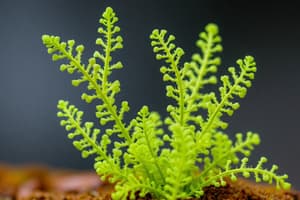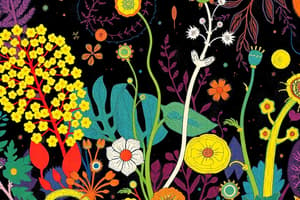Podcast
Questions and Answers
Which of the following is a characteristic of bryophytes?
Which of the following is a characteristic of bryophytes?
- Their gametophyte phase is larger and longer living than the sporophyte. (correct)
- Their sporophyte phase is dominant in the life cycle.
- They produce spores through meiosis.
- They have true roots for water and mineral absorption.
Which of the following is a characteristic of seedless vascular plants?
Which of the following is a characteristic of seedless vascular plants?
- They are typically found in dry environments.
- They lack vascular tissue.
- They produce spores through mitosis.
- They have flagellated sperm. (correct)
What is the function of the foot in the sporophyte of bryophytes?
What is the function of the foot in the sporophyte of bryophytes?
- It anchors the sporophyte to a substrate.
- It absorbs nutrients from the gametophyte. (correct)
- It produces spores.
- It conducts nutrients and water to the sporangium.
What is the function of xylem in vascular plants?
What is the function of xylem in vascular plants?
Which of the following is true about the gametophyte phase of seedless vascular plants?
Which of the following is true about the gametophyte phase of seedless vascular plants?
What is the function of rhizoids in seedless vascular plants?
What is the function of rhizoids in seedless vascular plants?
What is the ecological relevance of ferns?
What is the ecological relevance of ferns?
Which type of plants have specialized pores on leaves called stomata?
Which type of plants have specialized pores on leaves called stomata?
Which phase of the plant life cycle produces spores through meiosis?
Which phase of the plant life cycle produces spores through meiosis?
Which type of plants have flagellated sperm that swim to the archegonia for fertilization?
Which type of plants have flagellated sperm that swim to the archegonia for fertilization?
Where are apical meristems found in plants?
Where are apical meristems found in plants?
Which of the following traits are specialized and unique to plants that did not exist in previous ancestors?
Which of the following traits are specialized and unique to plants that did not exist in previous ancestors?
Which of the following is a structure involved in cell plate formation and subsequent division of daughter cells, found in certain Charophytes and plants only?
Which of the following is a structure involved in cell plate formation and subsequent division of daughter cells, found in certain Charophytes and plants only?
Which of the following is a trait shared by Charophyte green algae and plants?
Which of the following is a trait shared by Charophyte green algae and plants?
True or false: Phloem transports sugars, amino acids, and other organic products.
True or false: Phloem transports sugars, amino acids, and other organic products.
True or false: The gametophyte phase of seedless vascular plants is longer-lived and independent.
True or false: The gametophyte phase of seedless vascular plants is longer-lived and independent.
True or false: Rhizoids in seedless vascular plants are used to anchor the gametophyte to a substrate.
True or false: Rhizoids in seedless vascular plants are used to anchor the gametophyte to a substrate.
True or false: Charophyte green algae and plants share the same structure of flagellated sperm.
True or false: Charophyte green algae and plants share the same structure of flagellated sperm.
True or false: Cuticle is a specialized trait unique to plants that did not exist in previous ancestors.
True or false: Cuticle is a specialized trait unique to plants that did not exist in previous ancestors.
True or false: Sporopollenin prevents the zygote from drying out in charophytes and plants.
True or false: Sporopollenin prevents the zygote from drying out in charophytes and plants.
Non-vascular plants (bryophytes) have true roots for water and mineral absorption.
Non-vascular plants (bryophytes) have true roots for water and mineral absorption.
The sporophyte stage is dominant in the life cycle of seedless vascular plants.
The sporophyte stage is dominant in the life cycle of seedless vascular plants.
Bryophytes produce both sperm and egg in separate gametangia.
Bryophytes produce both sperm and egg in separate gametangia.
Vascular plants have specialized pores on leaves called stomata.
Vascular plants have specialized pores on leaves called stomata.
True or false: Stomata are specialized pores on leaves that support photosynthesis by allowing gas exchange of O2 taken in the outside air and release of CO2 (CO2 is a bi-product of photosynthesis).
True or false: Stomata are specialized pores on leaves that support photosynthesis by allowing gas exchange of O2 taken in the outside air and release of CO2 (CO2 is a bi-product of photosynthesis).
True or false: The gametophyte stage is a diploid, multicellular stage of the plant life cycle that produces spores by meiosis.
True or false: The gametophyte stage is a diploid, multicellular stage of the plant life cycle that produces spores by meiosis.
True or false: Sporangia are organs found in the sporophyte stage that produce spores through asexual reproduction.
True or false: Sporangia are organs found in the sporophyte stage that produce spores through asexual reproduction.
True or false: Bryophytes, lycophytes, and monilophytes are examples of nonvascular plants.
True or false: Bryophytes, lycophytes, and monilophytes are examples of nonvascular plants.
Flashcards are hidden until you start studying




